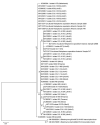Molecular Detection of Histoplasma capsulatum in Antarctica
- PMID: 36148943
- PMCID: PMC9514353
- DOI: 10.3201/eid2810.220046
Molecular Detection of Histoplasma capsulatum in Antarctica
Abstract
We detected Histoplasma capsulatum in soil and penguin excreta in the Antarctic Peninsula by sequencing after performing species-specific PCR, confirming previous observations that this pathogen occurs more broadly than suspected. This finding highlights the need for surveillance of emerging agents of systemic mycoses and their transmission among regions, animals, and humans in Antarctica.
Keywords: Antarctic regions; Antarctica; Histoplasma; fungi; histoplasmosis.
Figures


References
Publication types
MeSH terms
Substances
LinkOut - more resources
Full Text Sources
Medical

